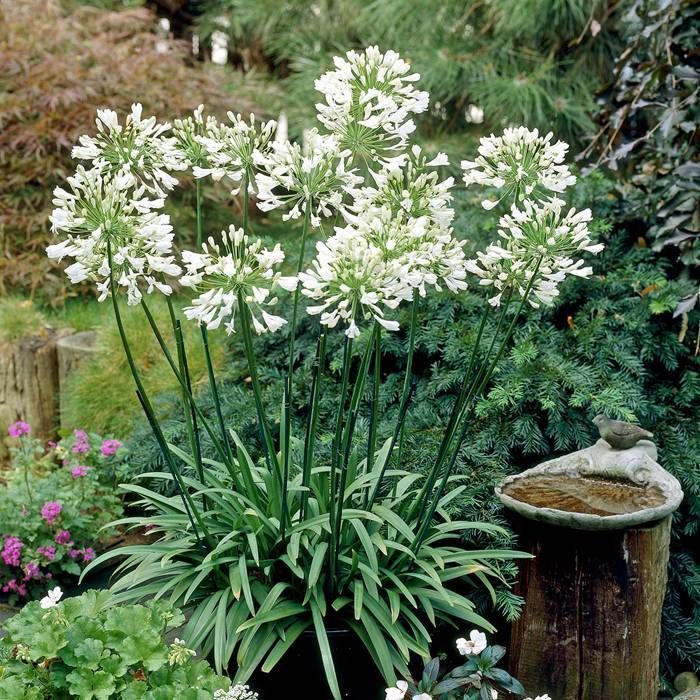Exactly how to Plant and Maintain Agapanthus in Your Garden
Exactly how to Plant and Maintain Agapanthus in Your Garden
Blog Article
Grasping the Art of Agapanthus Care: Vital Steps for Healthy Growth and Dynamic Blooms
In the world of horticulture, the cultivation of agapanthus stands as a rewarding undertaking for those who seek to support these classy flowering plants. From choosing the appropriate selection to grasping trimming techniques, the journey towards growing thriving agapanthus plants is complex and holds the crucial to unlocking the full capacity of these agricultural treasures.

Selecting the Right Agapanthus Selection

When selecting the best Agapanthus variety for your yard, think about variables such as climate viability, bloom color, and development habit. Agapanthus, frequently known as Lily of the Nile or African lily, comes in a variety of shades ranging from tones of purple and blue to white. Select a bloom color that matches your existing garden scheme to create an unified landscape. Additionally, think about the environment in your area to make certain the Agapanthus range you select can grow in your particular conditions. Some varieties are a lot more forgiving of cool temperatures, while others prefer warmer climates. Recognizing the growth practice of various Agapanthus selections is critical for appropriate positioning within your garden. Some selections have a clumping development habit, perfect for containers or boundaries, while others have an even more dispersing nature, appropriate for ground cover or mass growings. By very carefully evaluating these variables, you can select the best Agapanthus variety to enhance the elegance of your garden.
Suitable Growing Problems
Taking into consideration the ideal ecological demands is vital for effective Agapanthus cultivation. Agapanthus plants are delicate to cool temperature levels and need to be secured from frost throughout winter season months.
To ensure healthy and balanced growth and lively blossoms, plant Agapanthus light bulbs at a deepness of about 2-4 inches and space them 8-12 inches apart. Including raw material, such as compost, to the soil can boost drainage and fertility, promoting durable origin growth. Mulching around the base of the plants assists retain dampness and suppresses weed growth. Normal watering is crucial, especially throughout the growing season, to maintain the dirt continually damp yet not waterlogged.
Watering and Fertilizing Tips
Keeping correct moisture degrees and supplying important nutrients are key components in the treatment program for Agapanthus plants. When it comes to watering Agapanthus, it is critical to strike an equilibrium. These plants choose continually wet soil yet are vulnerable to root rot if overwatered.
Fertilizing Agapanthus is important for advertising healthy and balanced development and prolific blooms. Use a balanced plant food, such as a 10-10-10 formula, in the early spring as new growth arises. Repeat this application every 6-8 weeks throughout the growing period. Prevent too much fertilization, as it can cause lavish vegetation at the expenditure of blossoms. Constantly follow the supplier's directions for appropriate dilution and application approaches. By adhering site link to these watering and feeding pointers, you can ensure your Agapanthus plants thrive and generate dynamic, lasting flowers.
Trimming Methods for Agapanthus
Trimming Agapanthus plants at the appropriate times and with correct strategies is crucial for keeping their health and promoting optimum growth and flowering. The ideal time to prune Agapanthus remains in late wintertime or very early springtime before brand-new growth arises. Beginning by removing any kind of dead Read Full Article or yellowing fallen leaves near the base of the plant. Cut them as close to the ground as possible without harming the arising shoots.
Deadheading spent flowers can also reroute the plant's energy right into creating more blossoms instead than setting seeds. If you want to gather seeds for proliferation, leave some flowers to fully grown and completely dry on the plant.
Bear in mind to utilize tidy, sharp devices to make exact cuts and lower the threat of presenting conditions. Agapanthus. Normal trimming will aid keep your Agapanthus looking healthy and cool while ensuring a bountiful display screen of stunning blossoms
Dealing With Usual Bugs and Illness
After making sure appropriate trimming strategies for Agapanthus, it is necessary to address common insects and conditions that can affect the health and vigor of these plants. One usual bug that influences Agapanthus is the Agapanthus gall midget.
Additionally, Agapanthus plants can suffer from origin rot if they are grown in inadequately draining pipes dirt. By being attentive and taking timely action against diseases and insects, you can aid your Agapanthus plants flourish and create vivid blooms. Agapanthus.

Verdict
In final thought, understanding the art of agapanthus care includes choosing the right selection, giving ideal growing problems, proper watering and feeding, appropriate trimming methods, and addressing common pests and conditions. By following these necessary steps, you can make sure healthy and balanced development and lively flowers for your agapanthus plants. Keep in mind to frequently keep an eye on and keep your plants to promote their overall health and long life.
To ensure healthy development and lively blooms, plant Agapanthus light bulbs at a depth of concerning 2-4 inches and room them 8-12 inches apart. By complying with these watering and fertilizing ideas, you can guarantee your Agapanthus plants prosper and produce dynamic, durable flowers.
One common bug that affects Agapanthus is the Agapanthus gall midget. In addition, Agapanthus plants can endure from origin rot if they are planted in click this link poorly draining pipes soil. By complying with these necessary steps, you can ensure healthy and balanced growth and vibrant blossoms for your agapanthus plants.
Report this page